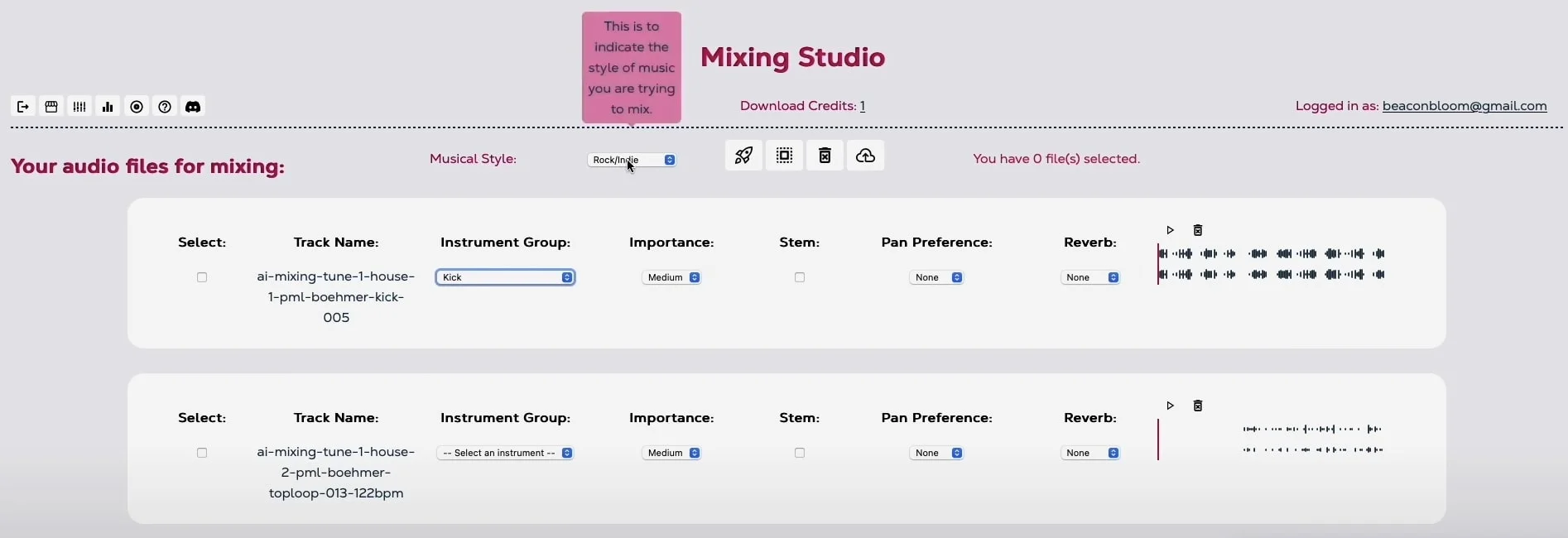How to use the AI Mixing and Mastering Studio
How to use the AI Mixing and Mastering Studio
If you've ever struggled with the mixing and mastering process of music creation - you're not alone. Mixing and mastering are both entire arts of their own, complex work that can take weeks to complete.
At Unchained Music, we are aware that not everyone is at that stage - most of us just want to make music get it out into the world at a professional standard.
This is where the AI Mixing Studio comes in, speeding up the process and letting you focus on what matters most - the music.
We've already created a video walkthrough of the process here - but for those more comfortable with text, let's continue on.
What does the AI Mixing Studio Do?
The Unchained AI Mixing Studio allows a user to upload audio tracks and stems from a song they are trying to finish. The user then provides us with some basic settings like musical style, what kind of instrument each track is and if they have any panning preferences. The AI listens to each track the user has submitted and figures out the best volume, equalisation, compression and panning settings for each track, so it can mix them and give the user back the best possible sounding track or stem. The service does all the legwork required for mixing, allowing the user to concentrate on the creative stuff. The result is a track that's available as either WAV, FLAC or MP3 ready to be distributed on music platforms such as Spotify, Soundcloud and Bandcamp.
Getting Started
Firstly, sign up to Unchained Music for free here if you haven't already.
Next, it's time to prepare your music for mixing.
Defining and Preparing Stems
In music production, a stem refers to an individual track or group of tracks that have been mixed together and then exported as a separate audio file. Stems typically contain a specific element of a song, such as vocals, drums, bass, or synths.
By exporting stems, music producers can later re-mix the track, adjust individual elements, or make different versions of the song for different purposes, such as for a radio edit, a remix, or for use in a commercial or film. Stems can also be used in live performances where they can be mixed in real-time or manipulated using effects to create unique performances.
To get your music ready for mixing, you'll need to export your song into stem groups, such as kick, bass, drums, guitar, vocal etc.
For more detail on preparing stems, and how to get them out of ableton into the Mixing Studio, see this blog post.
Let's get Mixing
Once your stems are exported and ready for mixing, head over to the AI Mixing and Mastering tool. You'll find a screen like this where you can sign in.

Log in with your details and then you'll be in the studio and will be presented with a screen like this:

Click "Choose Audio Files" and upload your stems.
Once uploaded, you can click "Add Files to Mix". A coffee filter icon will show, indicating that the studio is working.
Next, you'll see a screen like this:

First up to select your musical style.
Next, it's time to match your stems with the correct instrument group. In the case of the above screenshot, the first instrument is the kick - which, for electronic music has a high importance, has a pan preference of centre, and no reverb.
To complete the mixing process, complete this step for all the stems of your track.
Once you are finished, you can head over to the small rocket icon to mix your song. Once you click it, this screen will appear:

For most cases, the left option will be one the. Stem/Mix means that the studio will mix down all of your tracks into a single stereo file.
The master setting is if you already have a finished, single, stereo track that is mixed but not mastered - in this case, the mixing studio can do the mastering for you.
For this walkthrough, we're going with the option on the left - Stem/Mix. Click the Rocket Icon to mix your track.
This will take some time (although a lot less time than manually mixing a track!) so please be patient - clicking out of the screen will end the mixing process.
You will then see this screen:

Here you can listen to the track - if you need to make any adjustments, simply head back to the stem mixing page and change what you need to - this might be panning, track importance, reverb etc.
Once you are happy with your track, you can hit the small shopping cart icon to spend a mix credit and download your full resolution track.
And voila! Your track has been AI Mix/Mastered and is ready for distribution.
Still having trouble/have questions? See our video walkthrough here, flick us a message on our discord here, or see some FAQs below.
FAQS
Who owns the rights to the music I mix with your technology?
You retain all the rights your music. You uploaded your own stems and audio tracks, so the mixes created are yours.
Do I need to Master my mixed track?
Our AI mixing technology removes the need to have your tracks mastered. We take care of everything and every track we produce is ready for distribution - which you can do with Unchained Music for free here.
How do I get my mastered track to Spotify, Apple Music etc?
Simply sign up for Unchained Music and you can get your music to 220+ stores across the globe - including Spotify, Apple Music, TikTok, Tidal and Youtube - all 100% for free - we take no royalties.